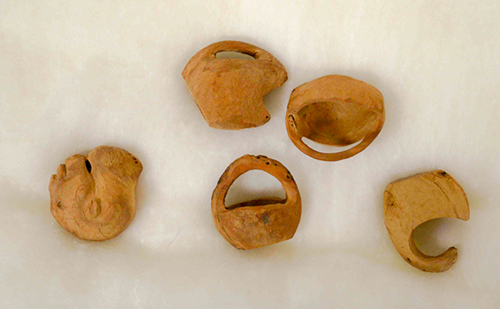
“I really feel that it is important to find out a little bit more who we are — who our immediate ancestors were, who our grandparents were, who our parents were. So much of society today, in my mind, is in a throw‐away mode, or a microwave mode. It’s just for the time being.”
Floyd is President of the Yucaipa Valley Genealogical Society. He encourages members to collect and pass on not only facts about their families, but also stories and objects.
I tell my genealogy society all the time, ‘It’s not just the date they were born, and where they got married, and the day they died. That’s not what we’re looking for. We want to know where it came from, how you got it, who was involved.’
Of course, Floyd collects stories and objects that relate to his own family lore, as well as his own upbringing in northern California and Arizona. Among these objects are a spoon and a collection of apricot pits, on display here. Together the items weave a story about the importance of family for furnishing not only an upbringing, but also an identity.
As to the spoon, Floyd fondly remembers dusting the curio cabinet together with his mother. As each object was lifted up, a story would emerge. One of these objects was a spoon from the Panama‐ California Exposition, held in San Diego in 1915 and 1916 as a precursor to world’s fairs.
Every time this would be picked up, when we were dusting, I would hear about Uncle Willis. They had gone together to the exposition ‐‐ He had taken his eight year old niece. She would just start telling me her memories of what it was like being there. Speckles Amphitheatre ‐‐ She talked about going to concerts there. And she would talk about being in awe of these various things.
Stories were also the primary focus of family me spent together on weekends.
After we moved to northern California we had a tradition ‐‐ on the weekend we set aside family me in the afternoon on Saturdays, and often times mother would read. In the springtime we had the fruit trees in the yard, and my dad would actually take the apricot pits while Mom was reading and us four boys were listening. He would sit there whittling away.
Floyd’s father would give the apricot pits to his children when he’d finished shaping them into whatever organically emerged that day. Five of these are on display here.
Each one has its own design. I’m not gonna say that he was a great sculptor; that’s not the point here. It’s that he always brought the best out of what he had in his hands.
There was a sense of marvel in Floyd as he watched his father’s hands work each pit into a masterpiece. He’d observe with curiosity, thinking,
‘I wonder what’s gonna show up this me. I wonder what he’s going to find in that’
Today Floyd follows in his father’s footsteps to uncover and shape what others might see as debris; he molds it into family lore. He also follows in his mother’s footsteps to cherish the power of objects to enhance the storytelling tradition.
We are – so many of us – we aren’t teaching our children that background, that history of where we came from. I’m not making a negative or positive judgment on that; it’s just where we are. And I think if we’re able to have a few things, within the family, that are special – it will assist in establishing roots. It gives us a tie, and a sense of belonging.